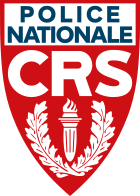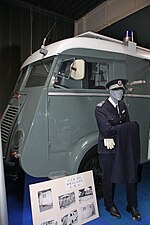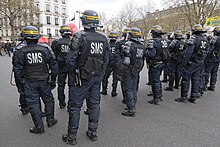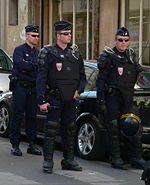The Compagnies républicaines de sécurité (French: [kɔ̃paɲi ʁepyblikɛn də sekyʁite], Republican Security Corps), abbreviated CRS, are the general reserve of the French National Police. They are primarily involved in general security missions, but the task for which they are best known is crowd and riot control. The DCCRS has seven units: in Paris, Lille, Rennes, Bordeaux, Marseille, Lyon and Metz.[1]
| Republican Security Companies Compagnies républicaines de sécurité (French) | |
|---|---|
 CRS patch | |
| Abbreviation | CRS |
| Motto | Servir To serve |
| Agency overview | |
| Formed | 1944 |
| Employees | c. 13.000 |
| Jurisdictional structure | |
| Operations jurisdiction | France |
| General nature | |
| Specialist jurisdiction |
|
| Website | |
| www | |



There are 60 "general service" CRS companies, specialized in public order and crowd control; nine "motorway" companies (French: Compagnies autoroutières) specialized in highway patrol in urban areas; and six "zonal" motorcycle units (one per Defense zone.[2]) Two additional companies and several mountain detachments administratively attached to local companies specialize in Mountain Rescue. One company (CRS n°1) specializes in VIP escort. The National Police band is also a CRS unit.[3]
Some of the CRS officers from the "general service" companies are cross trained and serve as lifeguards on the beaches during the summer vacations.
The expression "les CRS" refers to the whole force. The feminine singular "une CRS" means a company (the noun compagnie is feminine), but the masculine singular "un CRS" is often used to mean "a CRS man"; the press and laypeople frequently use "CRS" to mean any policeman in riot gear and wearing a helmet, whether he is a true CRS or a policeman or a gendarme mobile. The form "trois CRS" in theory means three companies, but is often used to mean three men.
History
editThe CRS were created on 8 December 1944, after the Groupes mobiles de réserve (GMR) (created by the Vichy régime) were dissolved. The CRS are a civilian corps (unlike the gendarmes, who are military), trained in anti-insurrection and antiriot techniques. The CRS saw their first serious action during the 1947 strikes in France.[4]
Communist sympathisers were strongly represented in the ranks of some of the early companies (due to their history of engagement in the French Resistance, and according to some - due to a desire to practice entryism).[5] The French Communist Party (PCF) took on the role of opposition to postwar governments. On 12 November 1947, there was a demonstration in Marseilles called by the communist union CGT and the French Communist Party; some of the local CRS (a majority of whom were communists at the time), refused to act against it and several companies were dissolved as a consequence while a few more were reorganized in 1948 to remove communist influence from their ranks.[5]
CRS detachments were created in some of the French overseas territories in 1950. The Guadeloupe and Réunion detachments were transformed into companies during the early 1960s but these were disestablished in the 1990s.[6] Up to sixteen additional companies were created in Algeria during the Algerian War of Independence and disestablished at the end of the conflict.[4]
CRS equipment and organization have evolved in phases. A major change in equipment followed the May 1968 demonstrations. During the 1990s, the equipment continued to evolve and the CRS were re-equipped with smaller vans to better adapt the companies to the urban environment (both in their surveillance and riot control missions).
Missions
editThe "general service" companies, together with the mobile gendarmerie, constitute a highly mobile reserve force for the government.[7] Their missions include:
- Providing security during large public events and mass gatherings such as ceremonies, sport events, festivals, concerts, and demonstrations
- Patrolling and securing specific areas (borders, suburban areas)
- Maintaining law and order during demonstrations, riot control
- Reinforcing local police forces in their general security missions
Organization
edit- 1 Central Directorate under a Director-general of the National Police in Paris
- 7 Zonal Directorates (one for each metropolitan military defence zone)
- 60 "General Service" Companies (for the maintenance of public order)
- 1 VIP Escort Compagny (CRS n° 1)
- 9 Autoroute Companies (dedicated to Highway Patrol)
- 6 Zonal Motorcycle Units
- 2 Mountain Companies (Alpes and Pyrenees) - specialized in Mountain Rescue
- The National Police Band (attached to CRS n° 1)[8]
Some of the CRS officers are cross trained and serve as lifeguards during the summer season. They also enforce applicable laws on the beaches.
The CRS are based in barracks but, unlike the gendarmes, they live at home when not on the road. A company typically spends more than 200 days per year away from its base town.
Company composition
editMost of the "general service" companies have a headquarters platoon and four line platoons (French: sections) each, a few companies having a sixth platoon (French: section des moyens spéciaux) or SMS equipped with special crowd/riot control equipment such as water cannons).
A complement of a regular company is as follows:
- 1 Company commander with the rank of Police Commandant (Major).
- 1 Police Captain
- 2 Police Lieutenants
- 1–4 Brigadiers-Major
- 12–25 Brigadiers-Chief
- 100–120 officers
- CRS vehicles
-
Van of a motorway company
-
CRS motorcyclists
-
CRS vans and truck during a demonstration - 2016
Criticism
editThe suppressive role and occasional abuse of force by the CRS[9] towards protesters[10][11] or even school children[12] has led to criticisms among human rights supporters. There have also been a number of complaints against CRS officers on the subject of racism[13] and racial profiling.
Note on the French mobile police forces
editThe two French anti-riot forces, the CRS and the Gendarmerie Mobile are often mistaken for each other, as some of their missions are similar,[14] but they can be distinguished by uniform. The uniform of the CRS is blue while that of the gendarmes mobiles is black. The CRS wear a big red CRS patch and their helmets sport yellow bands; the gendarmes have a stylized grenade on their medium-blue helmets.
In January 2009, the French state implemented a rapprochement ("bringing together") of the police and the gendarmerie.[15] While this policy falls short of a complete fusion or merger, as the gendarmes have kept their military status (while the CRS are a highly unionized civilian body), this has led to more commonality in terms of equipment for the two forces.
Notes and references
edit- ^ Aleksander Olech, French and Polish fight against terrorism, Poznan 2022, p. 91; https://www.researchgate.net/publication/359135918_French_and_Polish_fight_against_terrorism
- ^ There are seven metropolitan defense zones, but there is no zonal unit for the Paris region.
- ^ Ministerial order, September 1, 2016 modifying the ministerial order of May 29, 2009 relative to the organization and location of CRS units. https://www.legifrance.gouv.fr/eli/arrete/2016/9/1/INTC1618905A/jo/texte
- ^ a b Robert Le Texier, Les Compagnies Républicaines de Sécurité, éditions Lavauzelle, Paris-Limoges, 1981.
- ^ a b Maurice Agulhon and Fernand Barrat: C.R.S. à Marseille 1944-1947 6 Armand Collin, Paris 1971.
- ^ CRS companies were frequently deployed as reinforcement to the overseas departments and territories until the 1990s but this practice has been discontinued and only mobile gendarmerie units are sent overseas - or abroad - nowadays.
- ^ The generic term used by the French administration to describe both CRS and the mobile gendarmerie squadrons is "Unités de forces mobiles" (English: Mobile forces units).
- ^ "Direction centrale des compagnies républicaines de sécurité". DCCRS - Le site officiel du ministère de l'Intérieur de l'Outre-mer et des Collectivités Territoriales, 07/08/2009. Accessed May 12, 2010.
- ^ "Six CRS poursuivis pour violences envers des jeunes". Le Post. Archived from the original on 2011-10-03. Retrieved 2010-09-18.
- ^ Manif pour les retraites: les CRS matraquent des journalistes, Rue89
- ^ J'ai été tabassée par la police à la fin de la manif pour les retraites Rue89
- ^ "Vidéos sur l'actualité et info en vidéo - Le Parisien vidéo". leparisien.fr. Archived from the original on 2012-07-18. Retrieved 2010-09-18.
- ^ The Times[dead link]
- ^ The CRS are usually not deployed to the overseas French territories. The gendarmes, being part of the armed forces, can also be deployed on foreign theaters. For example, gendarmerie mobile squadrons were deployed in Afghanistan, Kosovo and the Ivory Coast.
- ^ http://www.vie-publique.fr/actualite/alaune/police-gendarmerie-rapprochement-officialise.html Police-gendarmerie: le rapprochement officialisé, January 6, 2009.
Bibliography
edit- Robert Le Texier, Les Compagnies Républicaines de Sécurité, éditions Lavauzelle, Paris-Limoges, 1981.
- Jean-Louis Courtois, CRS au service de la nation, C/O Crepin-Leblond, novembre 2004.
External links
edit- La Direction centrale des compagnies républicaines de sécurité, CRS page on the French National police website
- History of the CRS (in French)